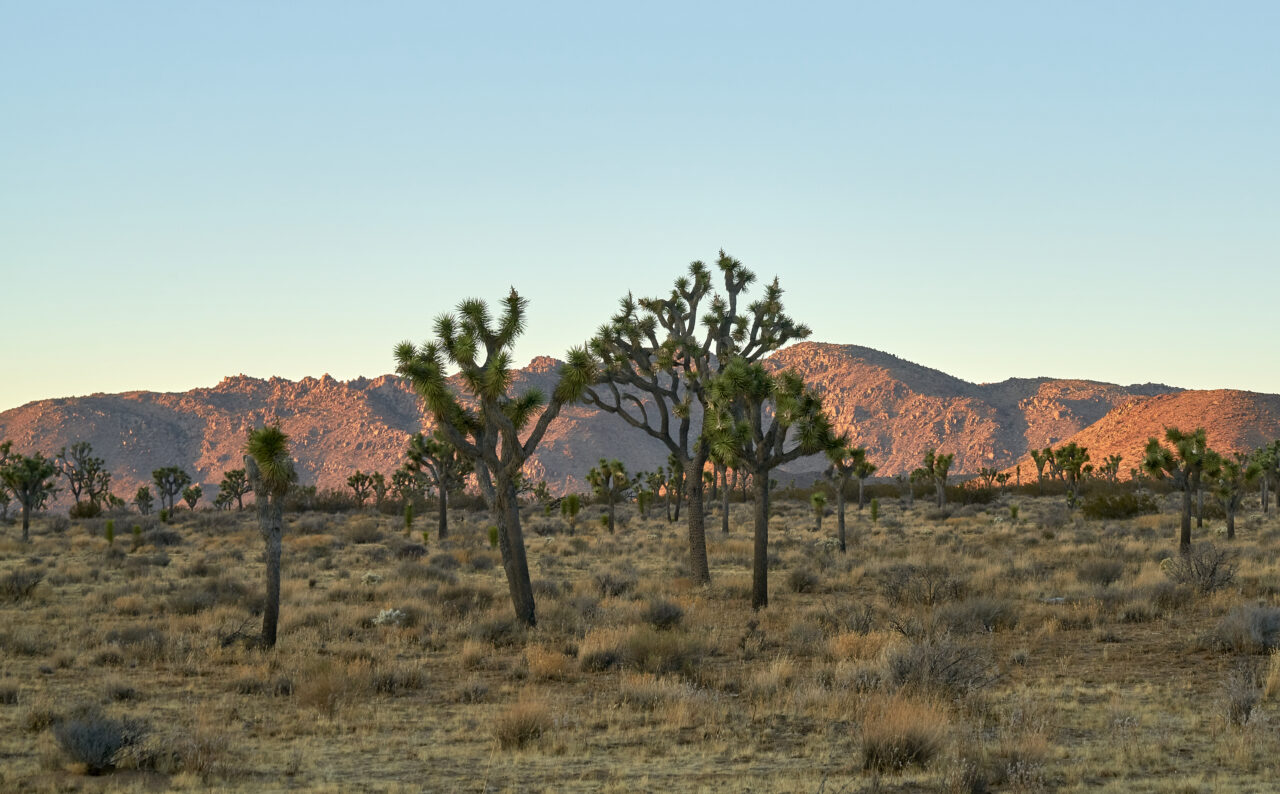Get more Southwest News & Travel Tips Here
Where is Joshua Tree National Park located?
Joshua Tree National Park is nestled in Southern California, primarily within San Bernardino County. The closest towns to the park are Joshua Tree and Twentynine Palms. Joshua Tree, a quaint town with a bohemian vibe, offers a glimpse into the area’s artistic side with local galleries and craft shops. Twentynine Palms, on the other hand, serves as a gateway to the park and is home to the renowned Joshua Tree Music Festival. The region is characterized by its unique desert landscape, dotted with iconic Joshua trees, massive boulders, and stunning rock formations.
Get more Joshua Tree National Park Travel Tips & News here!
Best Time to Visit Joshua Tree National Park
The ideal time to visit Joshua Tree National Park is during the spring (March to May) and fall (October to November) when temperatures are moderate, ranging from the mid-70s to low 80s during the day. Summer months can be extremely hot, with temperatures soaring above 100°F, making outdoor activities challenging. Winter offers cooler weather, but be prepared for occasional frost at night. The park can get crowded during holidays and weekends, so visiting during weekdays or off-peak seasons is recommended. Keep an eye out for annual events such as the Joshua Tree Music Festival in May and the Joshua Tree Art Walk in November for a unique experience.
How to get to Joshua Tree National Park?
Traveling to Joshua Tree National Park is convenient, with several airports in proximity. The nearest regional airport is Palm Springs International Airport (PSP), approximately 50 miles away. For international travelers, Los Angeles International Airport (LAX) is about 130 miles from the park, while Ontario International Airport (ONT) is around 70 miles away. Car rentals are available at all airports, providing easy access to the park. Alternatively, charter flights can be arranged to nearby airstrips for those seeking a more personalized travel experience.
What to do when you arrive:
Upon arrival, the Joshua Tree Visitor Center is your first stop. Open daily, it provides valuable information, maps, and exhibits about the park’s unique ecosystem. You can also purchase park passes and get advice from knowledgeable rangers. For accommodations, consider staying in the nearby towns of Joshua Tree or Twentynine Palms, where you’ll find a range of options from cozy motels to charming Airbnb rentals. Camping is also available within the park at designated campgrounds, providing a more immersive experience.
Getting Around Locally
Getting around Joshua Tree National Park is best done by car, as public transportation options are limited. The park is expansive, covering over 790,000 acres, so having your own vehicle allows you to explore at your own pace. There are several scenic drives within the park, including the main road leading to key attractions. Be sure to download a map or have a GPS device handy, as cell service can be unreliable in remote areas.
Top Things to Do and See at Joshua Tree National Park:
- Hidden Valley: This popular hiking trail offers an easy, 1-mile loop through a stunning valley surrounded by towering rock formations. It’s an excellent spot for rock climbing and photography.
- Cholla Cactus Garden: This unique area features a dense concentration of cholla cacti, making for an enchanting sight, especially during sunrise and sunset. A short, accessible trail allows visitors to stroll through the garden.
- Skull Rock: An iconic rock formation that resembles a skull, Skull Rock is located along the main road and is a great photo opportunity. Nearby, you can find a short trail that leads to additional fascinating rock formations.
- Barker Dam: This historic water reservoir offers a short hike to explore the dam and its surrounding landscape. Keep an eye out for local wildlife, including bighorn sheep and various bird species.
- Keys View: For panoramic views of the Coachella Valley and the San Andreas Fault, head to Keys View. Accessible by car, this lookout point is especially breathtaking during sunrise or sunset.
Suggested Itineraries
For a day trip, start at the Joshua Tree Visitor Center, then head to Hidden Valley for a morning hike. Next, visit the Cholla Cactus Garden for lunch and photos, followed by Skull Rock. In the late afternoon, enjoy the views at Keys View before heading back to town. For a weekend adventure, consider adding a camping experience at one of the park’s campgrounds, allowing for stargazing and nighttime exploration.
Permits & Fees
To enter Joshua Tree National Park, visitors must purchase a park pass. As of now, a standard vehicle pass is $30, valid for seven days. For those planning multiple visits, an annual pass is available for $55. Camping fees vary depending on the campground, so check the park’s official website for the most current information.
Nearby Day Trips & Detours
While visiting Joshua Tree, consider taking a day trip to nearby attractions. The Coachella Valley offers a vibrant arts scene and luxurious resorts. Additionally, the historic town of Pioneertown, famous for its Old West movie set, is just a short drive away. For a more adventurous excursion, head to the nearby San Bernardino National Forest for hiking and scenic views.
Local Culture & History
The history of Joshua Tree National Park is rich and diverse. The park is home to Native American tribes, including the Cahuilla and Serrano, who have lived in the area for thousands of years. The park was established as a national monument in 1936 and later designated a national park in 1994. Today, it serves as a sanctuary for wildlife and a haven for outdoor enthusiasts and artists alike, often inspiring creativity through its breathtaking landscapes.
Packing List & What to Bring
When visiting Joshua Tree National Park, it’s essential to pack wisely to ensure a safe and enjoyable experience. Here’s a comprehensive packing list:
- Clothing: Lightweight, breathable clothing for daytime; warm layers for evenings; a wide-brimmed hat for sun protection; and sturdy hiking boots.
- Sun Protection: High-SPF sunscreen, sunglasses, and lip balm with sunblock are crucial for protection against the harsh desert sun.
- Water: Hydration is key! Carry at least 1 gallon of water per person per day, especially during hikes.
- Food and Snacks: Pack non-perishable snacks like nuts, granola bars, and dried fruit for energy while on the trail.
- First Aid Kit: A basic first aid kit that includes band-aids, antiseptic wipes, pain relievers, and any personal medications.
- Navigation Tools: A physical map of the park, GPS device, or a fully charged smartphone with offline maps downloaded.
- Camping Gear: If you plan to camp, bring a tent, sleeping bags, cooking supplies, and portable chairs for comfort.
- Camera Gear: Capture the park’s stunning landscapes with a camera or smartphone, along with extra batteries and memory cards.
- Binoculars: Great for bird watching and spotting wildlife from a distance.
Wildlife & Nature Highlights
Joshua Tree National Park is renowned for its diverse and unique wildlife, making it a paradise for nature lovers. Here are some highlights:
- Joshua Trees: The park’s namesake trees are a unique species of yucca, characterized by their twisting branches and spiky leaves. They bloom in the spring, producing beautiful white flowers.
- Wildlife: Keep an eye out for desert creatures such as bighorn sheep, jackrabbits, coyotes, and various bird species like roadrunners and hawks. The park is also home to reptiles, including lizards and snakes.
- Stargazing: The park’s remote location and minimal light pollution make it a prime spot for stargazing. The Milky Way is often visible, and various astronomical events can be observed throughout the year.
- Unique Rock Formations: The park features stunning geological features such as granite monzogranite rocks, which have formed over millions of years. These formations attract rock climbers and photographers alike.
Accessibility Information
Joshua Tree National Park aims to provide access for all visitors. Here are some key points regarding accessibility:
- Visitor Centers: The Joshua Tree Visitor Center is wheelchair accessible, with accessible restrooms and parking available.
- Accessible Trails: The park offers a few accessible trails, including the Cholla Cactus Garden and the Hidden Valley Trail. These paths are paved or have compacted surfaces suitable for wheelchairs and strollers.
- Restroom Facilities: Accessible restrooms are located at the visitor center and several campgrounds throughout the park.
- Parking: Designated accessible parking spaces are available at key locations within the park, ensuring easy access to trails and viewpoints.
FAQs
Here are answers to some common questions about visiting Joshua Tree National Park:
- Is there an entrance fee? Yes, an entrance fee of $30 per vehicle covers a seven-day visit. Passes can be purchased at the entrance stations or online.
- Are pets allowed in the park? Pets are allowed in designated areas but must be on a leash and cleaned up after. They are not permitted on trails or in the backcountry.
- Can I collect rocks or plants? No, collecting natural resources like rocks, plants, or fossils is prohibited to preserve the park’s ecosystem.
- What should I do if I encounter wildlife? Observe wildlife from a safe distance and do not feed them. If you see a rattlesnake, give it space and allow it to move on.
Additional Resources
For further information and to plan your visit, check out these resources:
- Joshua Tree National Park Official Website
- Current Park Conditions and Alerts
- Frequently Asked Questions
- Park Map Download
- Weather Updates
Whether you’re seeking adventure, tranquility, or a deep connection with nature, Joshua Tree National Park offers a unique experience that leaves lasting memories. Plan ahead, respect the environment, and enjoy your time in this breathtaking desert landscape!
Follow us on social media for more!

